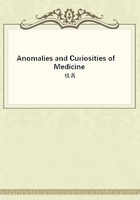
第8章
There are cases on record in which the menstruation occurs by the rectum or the urinary tract. Barbee illustrates this by a case in which cholera morbus occurred monthly in lieu of the regular menstrual discharge. Barrett speaks of a case of vicarious menstruation by the rectum. Astbury says he has seen a case of menstruation by the hemorrhoidal vessels, and instances of relief from plethora by vicarious menstruation in this manner are quite common. Rosenbladt cites an instance of menstruation by the bladder, and Salmuth speaks of a pregnant woman who had her monthly flow by the urinary tract. Ford illustrates this anomaly by the case of a woman of thirty-two, who began normal menstruation at fourteen; for quite a period she had vicarious menstruation from the urinary tract, which ceased after the birth of her last child. The coexistence of a floating kidney in this case may have been responsible for this hemorrhage, and in reading reports of so-called menstruation due consideration must be given to the existence of any other than menstrual derangement before we can accept the cases as true vicarious hemorrhage.
Tarnier cites an instance of a girl without a uterus, in whom menstruation proceeded from the vagina. Zacutus Lusitanus relates the history of a case of uterine occlusion, with the flow from the lips of the cervix. There is mentioned an instance of menstruation from the labia.
The occurrence of menstruation after removal of the uterus or ovaries is frequently reported. Storer, Clay, Tait, and the British and Foreign Medico-Chirurgical Review report cases in which menstruation took place with neither uterus nor ovary.
Doubtless many authentic instances like the preceding could be found to-day. Menstruation after hysterectomy and ovariotomy has been attributed to the incomplete removal of the organs in question, yet upon postmortem examination of some cases no vestige of the functional organs in question has been found.
Hematemesis is a means of anomalous menstruation, and several instances are recorded. Marcellus Donatus and Benivenius exemplify this with cases. Instances of vicarious and compensatory epistaxis and hemoptysis are so common that any examples would be superfluous. There is recorded an inexplicable case of menstruation from the region of the sternum, and among the curious anomalies of menstruation must be mentioned that reported by Parvin seen in a woman, who, at the menstrual epoch, suffered hemoptysis and oozing of blood from the lips and tongue.
Occasionally there was a substitution of a great swelling of the tongue, rendering mastication and articulation very difficult for four or five days. Parvin gives portraits showing the venous congestion and discoloration of the lips.
Instances of migratory menstruation, the flow moving periodically from the ordinary passage to the breasts and mammae, are found in the older writers. Salmuth speaks of a woman on whose hands appeared spots immediately before the establishment of the menses. Cases of semimonthly menstruation and many similar anomalies of periodicity are spoken of.
The Ephemerides contains an instance of the simulation of menstruation after death, and Testa speaks of menstruation lasting through a long sleep. Instances of black menstruation are to be found, described in full, in the Ephemerides, by Paullini and by Schurig, and in some of the later works; it is possible that an excess of iron, administered for some menstrual disorder, may cause such an alteration in the color of the menstrual fluid.
Suppression of menstruation is brought about in many peculiar ways, and sometimes by the slightest of causes, some authentic instances being so strange as to seem mythical. Through the Ephemerides we constantly read of such causes as contact with a corpse, the sight of a serpent or mouse, the sight of monsters, etc. Lightning stroke and curious neuroses have been reported as causes. Many of the older books on obstetric subjects are full of such instances, and modern illustrations are constantly reported.
Menstruation in Man.--Periodic discharges of blood in man, constituting what is called "male menstruation," have been frequently noticed and are particularly interesting when the discharge is from the penis or urethra, furnishing a striking analogy to the female function of menstruation. The older authors quoted several such instances, and Mehliss says that in the ancient days certain writers remarked that catamenial lustration from the penis was inflicted on the Jews as a divine punishment.